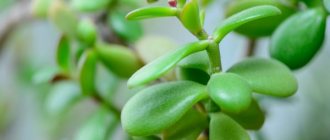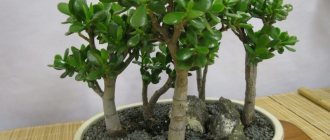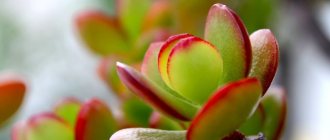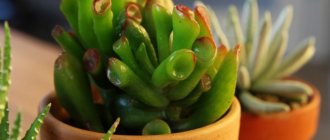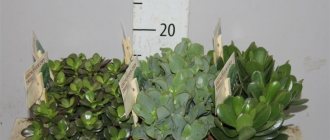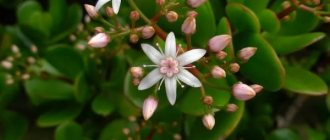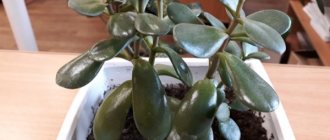| Crassula tetragonus | |
| Crassula tetragonum subsp. robusta , the larger subspecies that is most commonly cultivated. | |
| Scientific classification | |
| Kingdom: | Plantae |
| Clade : | Tracheophytes |
| Clade : | Angiosperms |
| Clade : | Eudicots |
| Order: | Saxifraga |
| Family: | Crassulaceae |
| Genus: | Crassula |
| Variety: | C. tetragona |
| Binomial name | |
| Crassula tetragonus | |
Crassula tetragonus
This is a succulent native to South Africa. Widely distributed from the Orange River border to Namaqualand beyond the Kei River to the Eastern Cape. "Tetragon" comes from the phyllotaxy of leaves. Among ornamental plant enthusiasts, it is often called "miniature pine" as it is widely used as a "pine" in bonsai.
Description
Lodging stems of Crassula tetragonum
subsp.
spiky foliage
The plant is erect or non-shrubby to 1 m (3 ft). It has woody stems with brown bark, with crossed pairs of leaves. Leaves are green to dark green. The plant has terminal inflorescences ending in white flowers that bloom in summer. Chromosome numbers vary: 2n = 16, 32, 48. Subspecies are divided geographically, usually with only one subspecies per geographic area.
What are the methods of propagation of Crassula?
There are several options for propagating succulent crops of the Crasula genus. Let's look at the main methods.
Reproduction of Crassula by seeds
Crassula seeds are sown in wide bowls. They are filled with a soil substrate based on sheet soil and sand (1 to 2). The top of the container is covered with glass, and condensation is removed daily. Crops are also regularly ventilated. You can observe the appearance of the first shoots after 2 weeks. When the seedlings grow up, they are planted in a large container, with a distance of 10 millimeters between the bushes. The container is filled with a sand-turf mixture. When the picking is completed, the container with succulents is placed in a room with good lighting. When they grow up, each bush is placed in a separate pot. The air temperature at first should be +16-18 degrees Celsius.
Reproduction by cuttings
Cuttings allow you to get new Crassulas much faster than using the seed method. Castings and sections of stems are used as cuttings. A large leaf plate or shoot is trimmed using a sharp knife.
Photos of Crassula cuttings
The cut areas are treated with charcoal crumbs. The cuttings are withered for 2-3 days, after which they are planted in a substrate based on sand or leaf soil. After the roots appear, each cutting is planted in an individual container. For cultivation you will need leaf and turf soil, as well as sand (ratio - 1 to 1 to 1). After this, the bushes can be placed in a permanent location, and care is provided in the same way as for adult representatives.
Taxonomy
The species was first described by Linnaeus in 1753 in his book Species Plantarum
[1] There are six recognized subspecies, originally named by Tolkien,[2] as follows:
- C. tetragona
subsp.
pointed foliage
, lodging stems, rooting in internodes and sharply pointed at the tips of the leaves. - C. tetragona
subsp.
tetragon
, a plant with multiple erect branches and a densely flowering inflorescence. - C. tetragona
subsp.
rudis
, a plant with a single main erect branch but with a weakly branched inflorescence. - C. tetragona
subsp.
indulges
, young stems papillose, thyrsus flower roundish - C. tetragona
subsp.
lignescens
Young stems are smooth, mature ones are woody, the leaves are relatively small. The most common subspecies. - C. tetragona
subsp.
Robusta
Young stems are smooth, the stems are completely braided, the leaves are large and strong. The most commonly cultivated subspecies.
Types of Crassula or Crassula
Let's look at the most popular plant varieties:
Crassula ovata
The most popular variety of Crassula among gardeners. Height in natural conditions is up to 3 meters. At home - up to one and a half meters.
Crassula ovoid or “Money tree” (commons.wikimedia.org)
The leaves are oval-shaped, have a glossy structure, and the color is green or grayish-silver. Umbrellas consist of white or pink flowers. It has high shade tolerance.
Crassula arborescens
Visually resembles the Crassula ovata variety. It has bare branches and a trunk; the leaf blades are flat but fleshy.
Crassula arborescens (wikimedia.org)
The color is pale blue, has a red border, up to 7 cm long. The inflorescences are panicle-shaped, have white or pink flowers. Does not grow in the shade, prefers only sunny areas.
Crassula lycopodioides
A shrub variety of Crassula, which has a fairly compact form. Height – no more than 25 centimeters.
Crassula lycophyte
The stems are fleshy and have curled tips. The species is undemanding in care and does well in light shade.
Crassula perforata
A small bush that is decorated with diamond-shaped leaves. The leaves are colored green, but with a bluish tint.
Crassula perforata
The edge has a red border.
Growth models
The plant requires a reasonable amount of water; If there are buds, more water is needed. Most species prefer full sun, although some subspecies may be sensitive to too much sun. The plant is frost tolerant but does best in temperatures above 40°F (4°C) (6C). The plant can be propagated by leaves and cuttings. It does not suffer from pests, except for the occasional mealy bug.[4]
- Inflorescence Crassula tetragonus
subsp.
robusta - Part sheet Crassula tetragonus
subsp.
lignescens
, the most common graceful subspecies in the habitat
Caring for Crassula at home
Soil type
A well-drained and light soil type is of great importance for the plant. It is important to note that it should not contain peat, as it retains a large amount of moisture.
In nature, fat plants prefer arid and rocky places; therefore, when growing this flower, soil mixtures intended for succulents are used.
Watering
Caring for Crassula at home includes following the watering regime. All representatives of the genus belong to drought-resistant plants. After watering, the soil must be completely dry before it can be moistened again. In winter, watering is reduced to once every 7-10 days.
See also: Indoor Croton how to care
During the hot summer period, it is enough to water once every three days. If you notice that the leaves turn yellow and fall off, it is most likely that there is an excess of moisture in the flowerpot. If a succulent does not receive enough moisture, its leaves will wrinkle.
Remember that the flower can easily tolerate drying out of the soil, but an excess of water when watering and high air humidity will be detrimental to it.
Sunlight and temperature
The culture loves bright lighting (4-5 hours a day), but without direct sunlight. These succulents cannot tolerate extreme heat. Loss of foliage and burns are a consequence of negative exposure to direct sunlight over a long period of time.
The optimal summer daytime temperature is 23-25 °C, and the nighttime temperature is up to 10 °C. This difference between day and night temperatures is beneficial for the succulent because it resembles its natural conditions.
During the winter rest period, the plant needs a cooler temperature in the range of 12-16 °C during the day; the fat plant can withstand a temperature drop of up to 7 °C, but this is its extreme limit.
The culture responds gratefully to exposure to fresh air, so if possible, take the flower pot to the balcony or terrace in warm weather. A lot of light, a lack of water and fairly cool conditions promote flowering.
Top dressing
During the growing season, fertilizing with mineral fertilizers for succulents is carried out according to the manufacturer's instructions.
In winter, there is no need to apply fertilizers, since during this period the plant is dormant.
Transfer
Since almost all types of crops grow quite slowly, replanting is carried out once every 2-3 years in a wide pot, since the roots of the crop are superficial.
Basic rules for replanting plants
With age, the root system of large tree-like crassulas weakens, and the crown becomes heavier with fleshy foliage, so a stable container is necessary for a money tree. At the bottom of the pot it is necessary to pour a drainage layer of expanded clay.
Crassula bonsai
Crassulas, especially tree-like varieties, are ideal for growing in the bonsai style, as the succulent shoots can withstand careful shaping. It is best to start with planted young plants obtained from rooted cuttings.
So that all the energy goes into forming the trunk, we plant it in a small, small but heavy pot. Several cuttings tucked together can, over time, create a beautiful grouping like a tiny forest.
Now the important task is to form the crown of the tree with miniature leaves, which is achieved by constantly pruning and pinching a new growth point, each time forcing the plant to branch out more.
As soon as you see the beginning of the growth of a new bud, immediately remove it carefully so as not to damage the sensitive stems. Two kidneys should appear in place of the removed kidney.
How to grow figs at home
When a mature tree is formed, any branches growing directly upward or downward are removed. The removed stems should have at least 4-5 leaves.
To maintain the plant at approximately the same size, it is necessary to trim the overgrown roots at the time of replanting. This will help develop a thick main trunk. We take a pot of the same size.
Trimming
Pruning is an important aspect in caring for Crassula at home. The procedure is mainly relevant for Crassula ovata and species with creeping or hanging shoots. Ideally, it should be carried out in the spring.
The procedure helps strengthen and rejuvenate the succulent, as well as stimulate new growth of the main stem and root system. For the Money Tree, pruning strengthens the side branches, helping them hold heavy leaves and form a compact, lush crown.
Reproduction
Crassula is easily propagated by leaf and stem cuttings. To root them, use a mixture based on soil for succulents and coarse sand in a ratio of 1:3. Pour a layer of sand on top of the soil mixture, about 5 cm. The procedure can be carried out in spring and summer.
To obtain cuttings, we cut off young shoots 5-6 cm long. We remove the lower leaves and dry the cuttings in a dark place for 1-2 days, then bury them in slightly moist soil. Seedlings quickly take root at a temperature of 23-25 ̊C in diffused sunlight.
Cuttings also quickly form roots in water, after which they are transplanted directly into pots.
For propagation by leaf cuttings, take healthy, developed leaves. They are buried in moist soil mixture. After a few weeks, new leaves and roots of young fat plants develop along the edges of the leaves in contact with the ground.
When they reach a few centimeters in height, they can be separated from the parent leaf and treated as individual plants.
Problems in growing
In a shady place, the plant's shoots become elongated and weaken. Poor succulent growth can also be caused by excess nutrients. Excessive watering and too low a temperature will quickly lead to the development of trunk and root rot and leaf loss. Crassula also responds to lack of moisture and high temperature by falling leaves. Brown, wrinkled spots on the leaves indicate insufficient watering.
How to make proper drainage
The most common fungal disease of Crassula is powdery mildew. A white coating appears on the leaves and young shoots, the leaves begin to fall off, and the young leaves become deformed.
The development of the disease is promoted by high humidity, water getting on the leaves, along with poor air circulation. In this case, the plant must be treated with a fungicidal preparation.
The money tree may become affected by pests such as mealybugs, aphids or spider mites.
Diseases of flowers - photos and descriptions
Pests can be easily removed by wiping the affected parts with a cotton swab dipped in alcohol or a soap solution to kill scale insects and aphids. The process must be repeated every day until complete recovery.
The plant is very sensitive to insecticides, so be careful when using these products.
Author: Yulia Zakrevskaya
- Decorative foliage
- Unpretentious
Comments
Tatyana 02/17/2013 14:06 mine grew gradually on the north window, the trunk and leaves were proportional, after I read about the sun, I exposed it and felt sorry for the trunk, it grew very quickly in height and the leaves began to fall off and spots formed on them, then There was a threat of the stem breaking; I had to break off all the stems, which were bending like rubber.
Answer
Natasha 02/26/2013 14:36 For some reason, my flower’s leaves have become limp. What about him? Maybe reduce watering?
Answer
Irina 02/28/2013 06:07 I quote Natasha:
For some reason my flower's leaves have become limp. What about him? Maybe reduce watering?
If you think you are watering too much, try reducing it.
And my money tree behaves like this when I dry it out - the leaves become limp and wrinkled. Reply Valentina 03/01/2013 12:27 The plant is mature, powerful, but has never bloomed. What is the reason?
Answer
Irina 03/02/2013 16:08 I quote Valentin:
The plant is mature, powerful, but has never bloomed. What is the reason?
Firstly, Crassula begins to bloom from 3-5 years of age.
Secondly, it must be well cared for - sufficient watering, lighting, fertilizing. Crassula is one of those plants in which flower buds are formed during the dormant period. At home, it will have to be created artificially. In September-October, gradually reduce watering of Crassula and move it to a cooler room with a temperature of 10-15 degrees. Do not water it at all for a month. Don't worry, she won't die. Even if the leaves wrinkle a little, they will recover when watering is resumed. After a month, you can bring Crassula out of dormancy by raising the temperature and gradually increasing watering. But still, this plant is kept more as an ornamental foliage plant, because its flowers are small and inconspicuous. Reply Valentina 03/03/2013 00:05 Thank you very much for the advice, I’ll try in the fall.
Answer
Lyudmila 04/27/2013 23:27 And my tree is good, the leaves are juicy and elastic. But for some reason they began to fall off, just some kind of leaf fall. Even the young shoots fall off. They don’t wither, don’t dry out, but just good leaves fall. It’s standing near the window, there’s enough light. Feed it. Maybe it’s time to replant?
Answer
Lyudmila 04/27/2013 23:29 Help with advice, please. I feel so sorry for him, I love this tree so much.
Answer
Irina 04/28/2013 11:20 I quote Lyudmila:
And my tree is good, the leaves are juicy and elastic. But for some reason they started to fall off, like some kind of leaf fall. Even the young shoots fall off. They don’t wither, they don’t dry out, but just good leaves fall. It’s standing near the window, there’s enough light. I feed it. Maybe it’s time to replant?
Stop feeding her for a while until her condition returns to normal.
Only completely healthy plants are fed. The reason for the loss of good leaves may be the flooding of the plant. Crassula does not like frequent heavy watering. Try not watering it for a few days, maybe a week. At this time, spray with Epin - it increases the resistance of plants to stressful situations. Reply Lyudmila 04/28/2013 23:36 I water once a week. Is this often? Need it less often? I will definitely buy the drug. Thank you very much.
Answer
Irina 04/29/2013 03:50 I quote Lyudmila:
I water once a week. How often? Need it less often? I will definitely buy the drug. Thank you very much.
Lyudmila, a plant’s need for watering cannot be measured by quantity.
Much depends on the size of the pot and the size of the root system, as well as the health of the plant. If the pot is large and the root is small, then the soil will remain wet for a long time, since the roots do not have time to absorb all the water in a short time. This is where the bay comes from. And when a plant is sick, it also drinks little water. The top layer of soil must dry out 2-3 cm deep between waterings. Reply Update list of comments

